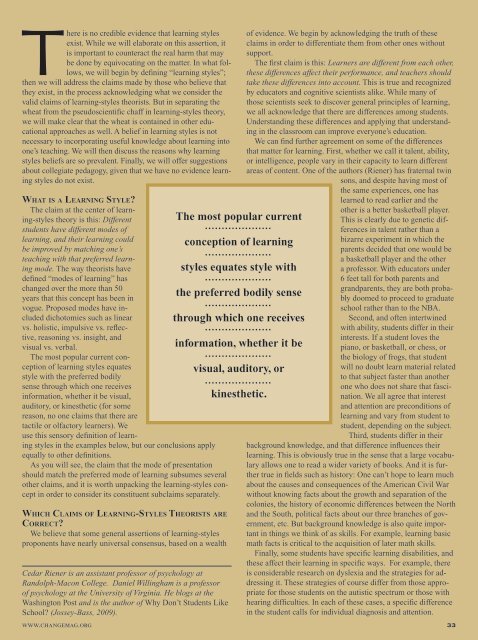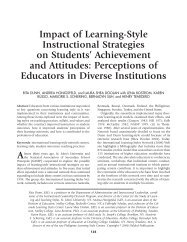THE MYTH OF LEARNING STYLES
The Myth of Learning Styles - People to People
The Myth of Learning Styles - People to People
- No tags were found...
Create successful ePaper yourself
Turn your PDF publications into a flip-book with our unique Google optimized e-Paper software.
There is no credible evidence that learning styles<br />
exist. While we will elaborate on this assertion, it<br />
is important to counteract the real harm that may<br />
be done by equivocating on the matter. In what follows,<br />
we will begin by defining “learning styles”;<br />
then we will address the claims made by those who believe that<br />
they exist, in the process acknowledging what we consider the<br />
valid claims of learning-styles theorists. But in separating the<br />
wheat from the pseudoscientific chaff in learning-styles theory,<br />
we will make clear that the wheat is contained in other educational<br />
approaches as well. A belief in learning styles is not<br />
necessary to incorporating useful knowledge about learning into<br />
one’s teaching. We will then discuss the reasons why learning<br />
styles beliefs are so prevalent. Finally, we will offer suggestions<br />
about collegiate pedagogy, given that we have no evidence learning<br />
styles do not exist.<br />
What is a Learning Style?<br />
The claim at the center of learning-styles<br />
theory is this: Different<br />
students have different modes of<br />
learning, and their learning could<br />
be improved by matching one’s<br />
teaching with that preferred learning<br />
mode. The way theorists have<br />
defined “modes of learning” has<br />
changed over the more than 50<br />
years that this concept has been in<br />
vogue. Proposed modes have included<br />
dichotomies such as linear<br />
vs. holistic, impulsive vs. reflective,<br />
reasoning vs. insight, and<br />
visual vs. verbal.<br />
The most popular current conception<br />
of learning styles equates<br />
style with the preferred bodily<br />
sense through which one receives<br />
information, whether it be visual,<br />
auditory, or kinesthetic (for some<br />
reason, no one claims that there are<br />
tactile or olfactory learners). We<br />
use this sensory definition of learning<br />
styles in the examples below, but our conclusions apply<br />
equally to other definitions.<br />
As you will see, the claim that the mode of presentation<br />
should match the preferred mode of learning subsumes several<br />
other claims, and it is worth unpacking the learning-styles concept<br />
in order to consider its constituent subclaims separately.<br />
Which Claims of Learning-Styles Theorists are<br />
Correct?<br />
We believe that some general assertions of learning-styles<br />
proponents have nearly universal consensus, based on a wealth<br />
Cedar Riener is an assistant professor of psychology at<br />
Randolph-Macon College. Daniel Willingham is a professor<br />
of psychology at the University of Virginia. He blogs at the<br />
Washington Post and is the author of Why Don’t Students Like<br />
School? (Jossey-Bass, 2009).<br />
The most popular current<br />
conception of learning<br />
styles equates style with<br />
the preferred bodily sense<br />
through which one receives<br />
information, whether it be<br />
visual, auditory, or<br />
kinesthetic.<br />
of evidence. We begin by acknowledging the truth of these<br />
claims in order to differentiate them from other ones without<br />
support.<br />
The first claim is this: Learners are different from each other,<br />
these differences affect their performance, and teachers should<br />
take these differences into account. This is true and recognized<br />
by educators and cognitive scientists alike. While many of<br />
those scientists seek to discover general principles of learning,<br />
we all acknowledge that there are differences among students.<br />
Understanding these differences and applying that understanding<br />
in the classroom can improve everyone’s education.<br />
We can find further agreement on some of the differences<br />
that matter for learning. First, whether we call it talent, ability,<br />
or intelligence, people vary in their capacity to learn different<br />
areas of content. One of the authors (Riener) has fraternal twin<br />
sons, and despite having most of<br />
the same experiences, one has<br />
learned to read earlier and the<br />
other is a better basketball player.<br />
This is clearly due to genetic differences<br />
in talent rather than a<br />
bizarre experiment in which the<br />
parents decided that one would be<br />
a basketball player and the other<br />
a professor. With educators under<br />
6 feet tall for both parents and<br />
grandparents, they are both probably<br />
doomed to proceed to graduate<br />
school rather than to the NBA.<br />
Second, and often intertwined<br />
with ability, students differ in their<br />
interests. If a student loves the<br />
piano, or basketball, or chess, or<br />
the biology of frogs, that student<br />
will no doubt learn material related<br />
to that subject faster than another<br />
one who does not share that fascination.<br />
We all agree that interest<br />
and attention are preconditions of<br />
learning and vary from student to<br />
student, depending on the subject.<br />
Third, students differ in their<br />
background knowledge, and that difference influences their<br />
learning. This is obviously true in the sense that a large vocabulary<br />
allows one to read a wider variety of books. And it is further<br />
true in fields such as history: One can’t hope to learn much<br />
about the causes and consequences of the American Civil War<br />
without knowing facts about the growth and separation of the<br />
colonies, the history of economic differences between the North<br />
and the South, political facts about our three branches of government,<br />
etc. But background knowledge is also quite important<br />
in things we think of as skills. For example, learning basic<br />
math facts is critical to the acquisition of later math skills.<br />
Finally, some students have specific learning disabilities, and<br />
these affect their learning in specific ways. For example, there<br />
is considerable research on dyslexia and the strategies for addressing<br />
it. These strategies of course differ from those appropriate<br />
for those students on the autistic spectrum or those with<br />
hearing difficulties. In each of these cases, a specific difference<br />
in the student calls for individual diagnosis and attention.<br />
www.changemag.org 33





